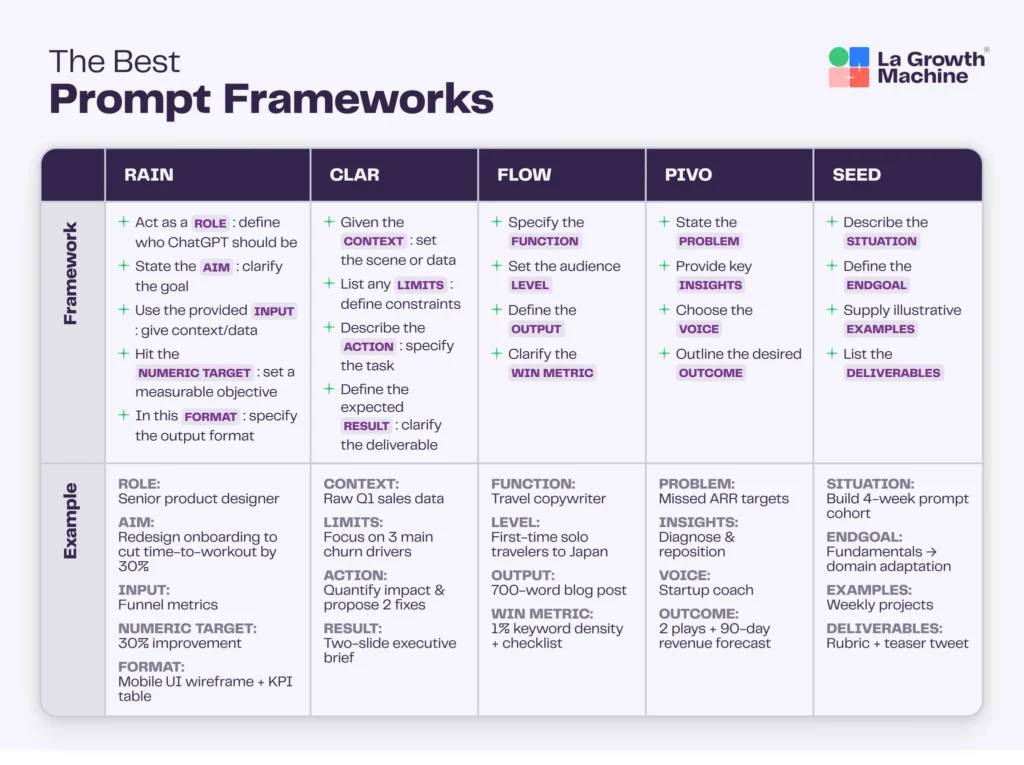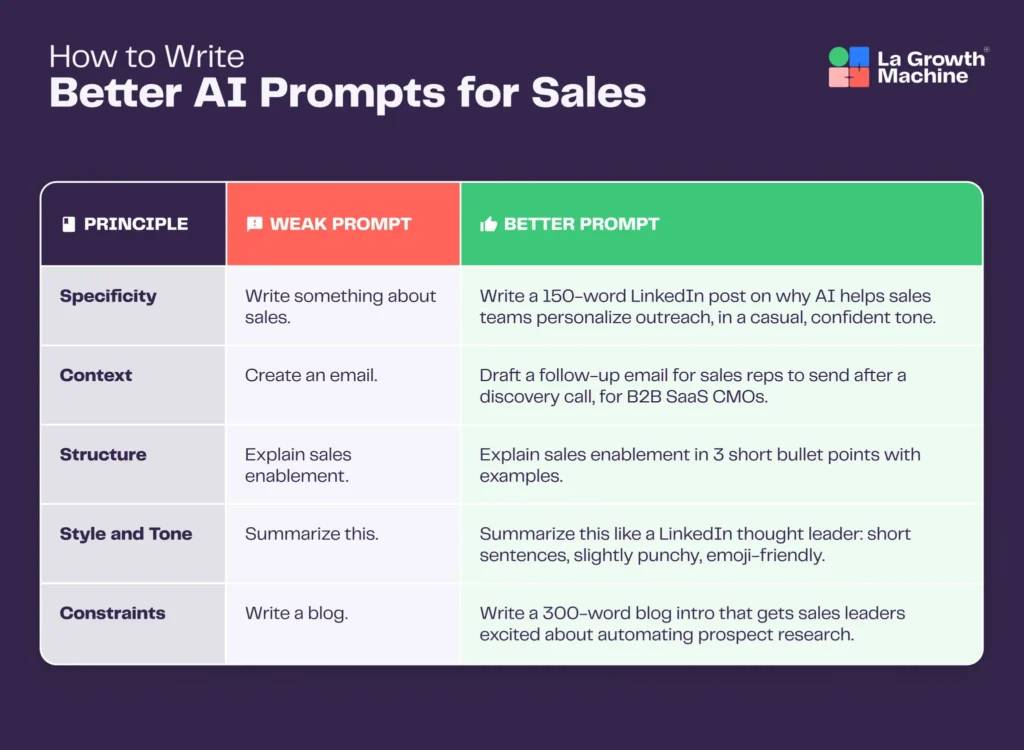Whether you’re working these into your sales automation stack, a manual one-off, or a smart sequence powered by AI, here’s how to write prompts that get you better first drafts, faster.
Example 1: Thank you follow-up
You’re [your role].
[context about the previous contact]
Create a follow-up email to thank [prospect’s name] for a recent meeting.
Mention specifics from the conversation, express enthusiasm about moving forward, and ask if they need more information.
Keep it friendly, concise, and briefly recap the next steps.
Example 2: Information follow-up
You’re [your role].
[context about the previous contact]
Generate a follow-up email for [prospect’s name] providing additional details on a document or resource you discussed.
Explain why it matters for them and invite questions.
Keep the tone helpful and non-pushy.
Example 3: Feedback follow-up
You’re [your role].
[context about the previous contact]
Draft a follow-up to [prospect’s name] asking for their thoughts on a [proposal/demo/document] you sent last week.
Suggest scheduling a short call if they want to explore specifics.
Example 4: LinkedIn follow-up
You’re an expert LinkedIn strategist.
A prospect replied positively but vaguely to your outreach.
[context about the previous contact]
Write 2 short follow-up messages that:
- Mirror their tone and style
- Stay under 300 characters
- Use 2–5 simple sentences
- End with: “How does that compare to what you do today?”
- Reference their reply, personalize with a small detail, mention a tangible result (like “+35% reply rate”), and focus on a single pain point.
- No generic intros, max 15 words per sentence, spark curiosity.
After prompting AI to help with the output, you can automate it in LGM.
Here’s a call prompt to help you spark interest, establish relevance, and confidently ask for a meeting, without sounding scripted.
“You will be writing a cold call script to book a meeting with a [specific persona] at a [target company].”
Structure your script using this proven framework:
- Start with a brief introduction and mention a research-backed industry insight
- Ask for permission to continue (2-minute request)
- Present a specific challenge relevant to their persona and company type
- Include a trigger that causes this problem
- Explain how your solution addresses the identified problem
- Keep it concise and benefit-focused
- Reference social proof from similar companies/personas
- Propose specific timeframes
- Close with confidence about the value you can deliver
The goal is to capture their interest, establish a need, present your [solution’s value], and close for a meeting, while maintaining a conversational tone that feels natural and informed.
Use placeholders like [persona], [company], [industry], [solution], and [value props] to ensure the script can be easily customized for different prospects.
And it gives:
“Hi, this is [your name] from [your company]. I’m calling to speak with the [persona] at [company]. Before I explain why I’m calling, I wanted to mention [insert research observation, e.g. many companies in your industry struggle with X”]. Would it be okay if I took 2 minutes to explain a common [persona] challenge we help solve?
Many [persona] like yourself at companies like [company] face issues with [state a relevant problem, e.g. “inefficient processes leading to missed sales opportunities”]. This is often triggered by [insert trigger, e.g. “lack of visibility into the full sales pipeline”].
We help [persona] at [type of company] address this by [explain how your solution solves the problem, e.g. “providing a centralized CRM that gives full transparency into every deal”].
I’d be happy to walk you through exactly how we’ve helped other [persona] in [industry] overcome similar challenges. Would you have 30 minutes sometime this week or next to discuss further? I’m confident our solution could drive significant [value props] for [company].“
Morgan J. Ingram is known for his hyper-personal, concise LinkedIn outreach.
He analyzed DMs that got replies to reverse-engineer what works. Then, he let AI do 80% of the drafting, while he added the final 20% of human nuance. With this method, he booked 5 qualified meetings in 3 weeks.
The prompt to give your LLM:
“You are an expert LinkedIn sales messaging strategist with 20+ years of experience crafting messages that generate high response rates from C-suite executives.
Analyze these LinkedIn messages to my target prospects that have positive responses: [insert their messages]
Create [number] response templates that:
1. Mirror their communication style while maintaining my authentic voice
2. Are under 300 characters (not words) to ensure readability
3. Contain 2-5 concise sentences at a 3rd-4th grade reading level
4. End with exactly one of these questions:
- “How does that compare to what you do today?”
- “How are you currently doing this internally?”
Essential elements to include:
- Reference a specific detail from their message
- Insert a personalization placeholder showing I’ve researched them
- Mention one clear customer result with a specific metric
- Focus on solving ONE specific problem they likely face
Writing requirements:
- No generic openings like “Hope all is well”
- Use simple, direct language a 9-year-old would understand
- Limit each sentence to 15 words maximum
- Create curiosity without being vague
After providing the templates, suggest 3 specific variables I could A/B test to improve response rates, with concrete examples of each variation.“
Why it works:
This prompt doesn’t just generate a cold LinkedIn DM. It reverse-engineers why top messages got engagement, then builds fresh templates that are short, personal, curiosity-driven, and laser-focused on one problem, exactly how AI for sales emails and DMs should work.

